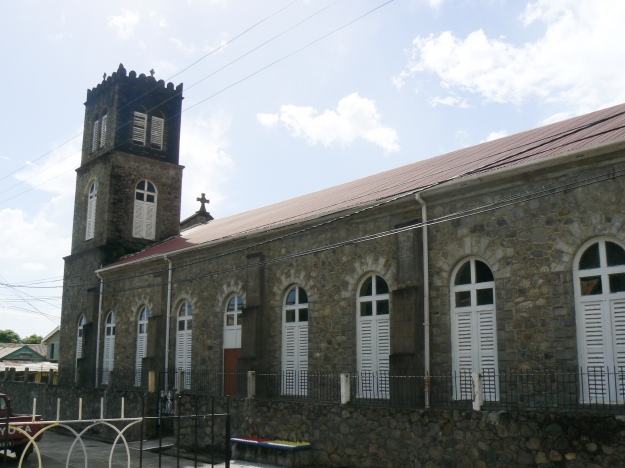Fr. George Paddington, the first black priest in Dominica
Part 2 by Bernard Lauwyck

The St. Peter’s church in Colihaut: the location of Fr. Paddington burial
A few weeks ago I promised to let you know more about the first black priest in Dominica, Rev. Fr. George or Georges PADDINGTON.
I did not get back to you earlier as I was waiting for a book named “STAMPED WITH THE IMAGE OF GOD, African Americans as God’s Image in Black” which I hoped would provide me with additional information . Was I disappointed with the paucity of information on him, when I received this otherwise very interesting book !
The authors describe Fr. Paddington as “ a very important historical figure in black Catholic history ” as “one of the first priests of African descent outside Africa”.
They got access to his letters written in 1836 from Haiti to the Blessed Pierre Toussaint, an ex-slave in New York, who will be recognized as a black saint soon. These letters are stored on a microfilm in the New York Public Library. An interesting bit of information is that Fr. George came from an acrobat family in Ireland. Arthur Jones the author of “PIERRE TOUSSAINT, A BIOGRAPHY” refers several times to Fr. Paddington’s letters. He claims that these letters are extremely important for historians of black Catholicism.
While I waited on the above mentioned book, I continued my research in French and English documents as I realised that I was breaking new ground with my own research on this black priest buried in Colihaut .
What did I find out from different sources ?
In 1836 Paddington wrote his letters from Haiti to Pierre Toussaint . He had gone to Haiti as an Irish seminarian and his command of French, a language he needed to minister in Haiti, was weak. He received both the minor and the major orders, and was ordained on 21 May 1836 in Port-au-Prince by an US Bishop named John England of the Diocese of Charleston, South Carolina. Most Rev. England, who at the time was Apostolic Delegate of Haiti, was originally from the same Irish Diocese as Paddington, which might have played a role in the selection of Fr. Paddington .
Around 1839, George Paddington wrote that he was planning to go and finish his studies in Rome and France .
Fr. Paddington is several times mentioned in “L’HISTOIRE RELIGIEUSE D’HAITI” , “LES MISSIONS CATHOLIQUES FRANÇAISES AU XIXE SIÈCLE/ MISSIONS D’AMÉRIQUE” and “HISTOIRE D’HAÏTI, VOL. 8”.
In April 1843 Fr. Georges can be placed at “the College de la Propagande”, an international seminary in Rome, where he met Abbé Tisserand, a man who was determined to bring the gospel to the descendents of African slaves.
Fr. Paddington returned to Haiti with Abbé Tisserand . “Abbé Georges Paddington, du diocèse de Kerry, en Irlande ” left Le Havre in France on the 3rd of February 1845 for Haiti on an oceanliner. They arrived at Jacmel in Haiti on the first of March 1845.
“A few excellent Priests, for the greater part members of the Congregation of the Sacred Heart of Mary, instituted for the conversion of the negroes, were sent to Haiti, under the direction of l’Abbé Tisserand… The Haitian people then, at length, saw Priests full of zeal, disinterested, pure in morals, and who—strangers to the dissensions of party [politics]—limited their ambition to the saving of souls, to the enlightening of the ignorant, to succouring the poor and visiting the sick. Unhappily, the title of Prefect Apostolic, with which Tisserand had been invested by the Holy See… excited much opposition in Haiti, and the Government refused to acknowledge him. ” extract from THE TABLET archives of June 1846.
As the situation in Haiti became untenable, due to the Haitian government’s restrictions on clergy, Fr. Paddington left and travelled to Trinidad, an island with many French colonists.
Bishop Richard P. Smith wrote from Port of Spain (Trinidad) on November 4, 1849 to Cardinal Fransoni, Prefect of the Sacred Congregation of Propaganda Fide that Abbé Paddington had arrived in Trinidad from Santo Domingo, about two months before. Smith advised Paddington to report to the Cardinal everything relating to the Mission of Haiti, and to await orders . In the mean time Bishop Smith gave him a post on Dominica . Bishop Smith concluded that he had learned that Fr. Paddington “ is doing much good, and that he is respected and esteemed” in Dominica. [Source: Archives of Propaganda Fide, Rome SOCG 1849-1850 (v. 971) fols 136-145. In French]
In Dominica, Fr. George(s) Paddington was appointed parish priest of St. Peter’s in Colihaut . He mostly resided at Dublanc. Two years after his arrival in Dominica on August 28, 1849 , he became incapacitated by illness. He died and was buried in the shadow of the little parish church in Colihaut, built by his predecessor. His remains were interred under the High Altar of the present St. Peter church in Colihaut, which was built in later years.
Fr. Paddington came with excellent credentials : Abbé Tisserand, his superior called him a pious priest: “ le pieux abbé Georges Paddington”.
The venerable Francis Liberman praised him as “one of our most fervent novices, a man who will rejoice your heart” quote from THE SPIRITUAL LETTERS OF THE VENERABLE FRANCIS LIBERMANN (1802-1852)
Fr. George(s) Paddington, a saintly black priest, buried in the Colihaut church, was forgotten in Dominica up till now.



